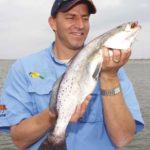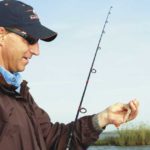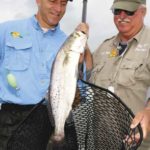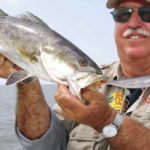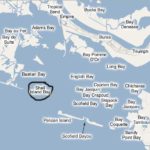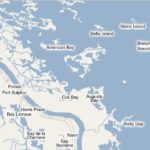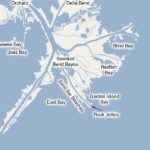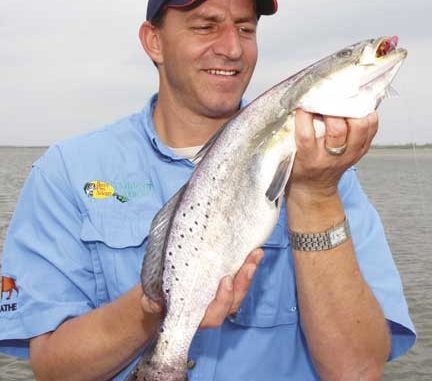
Mother Nature threw Plaquemines Parish a curveball this year, but May is the month speckled trout anglers should hit it out of the park.
The mouth of the Mississippi River has been an absolute mess this year. If the relentless wind wasn’t bad enough, old Mother Nature made it even worse by pounding the upper Mississippi River Valley with more rain than the river could contain.
All that fresh water had to go somewhere, and it did. It flowed right down to Louisiana and out Southwest Pass, South Pass, Pass a Loutre — you get the picture. All the footage of the flooded Midwest might not have affected you in your living room, but it did affect all the anglers trying to fool trout from Empire to Venice.
The river crested in mid-April at 17 feet in New Orleans, with local officials on standby to combat any potential problems. The high river even forced officials to open the Bonnet Carre Spillway to keep the city safe.
Along with all the fresh water the high river brought to Plaquemines Parish, it also brought along tons of mud. Some anglers were talking about there being so much mud in the river that coons could walk from one side to the other without even getting the tops of their feet wet. All anglers could do was dream of better days to come.
Those better days officially start in May. According to Capts. Owen Langridge and Lloyd Landry, the winds should be calmer, the water should be clearing up and the water should start receding to normal levels.
However, whether the river does get right or not, both anglers say there is no better time to catch big speckled trout down in Plaquemines Parish than May. If we have a late high river, they can still be caught — it just takes a little more time and effort. Whatever it is, it’s got to be better than January, February or March.
“These big fish have been in the marsh and in the river system all winter,” Langridge said. “We’ve had an exceptionally high river, but we still have salt water on the bottom. The thing is, the trout haven’t fed very well so far this year because of the cold river water.
“Thankfully, they will get active during May, and move out of the marsh and to the beaches and in the bays where they will start to spawn. There is usually a little bit of a spawn in April, but the first major one is in May. That’s why everybody wants to come down here to catch sow trout this month.”
For charter captains, the reputation of Plaquemines Parish as being a May hotspot for big trout is a great blessing, but it can also be a curse in disguise. Anglers get so jacked up about catching sow trout that they want to catch an entire limit of big trout.
Landry adamantly explained that even though there are big trout to be caught, it just doesn’t work that way.
“I’ll get customers who want to leave biting trout to go try for big fish,” Landry said. “After a few fishless hours, they want to go back to fish the smaller trout again. Well, something changes while we’re gone, and those small fish might be gone or they’ve stopped biting. You can’t have your cake and eat it too down here, so I ask the guys who want big trout if they are willing to go home with just a few fish rather than a box of them.”
And that’s the way it is with big trout. You have to have more patience and be willing to accept the fact you might only catch seven, eight, nine or 10 fish in the 4-pound class rather than 25 keepers.
Langridge sees some similarities between catching big trout and bass fishing.
“A big trout is like a bass in that you have to be able to attract the fish and get him to bite,” he said. “You’ve got to be quiet in your boat because these big girls are very spooky this time of year. These fish are in 2 or 3 feet of water, and banging around in your boat will scare them off. That’s a sure way to not catch big trout.”
Langridge and Landry focus on two separate sections of Plaquemines Parish to catch big trout during May. Langridge prefers the mouth of the river, and Landry likes to fish farther to the north as long as he can get away with it.
And according to Langridge, catching large trout in northern Plaquemines Parish is more common after Katrina than it was before.
“While I love the mouth, there’s no line I can draw and say to stay below it for the largest trout,” Langridge explained. “There are a lot of big fish coming from places like Pointe a la Hache and Port Sulphur since Katrina. I can’t really explain why this is happening, but you can definitely see it during May and June.”
Since Landry would rather stay north toward Buras and Empire during May, he explained how other anglers could take advantage of the big bite to be found along this section of the river. Whether you fish the east side of the river or the west, Landry’s advice will go a long way toward increasing the size of the trout you catch this year.
One of the most important things Landry has discovered is paramount to catching large trout is to try to fish near the peak of an incoming tide. Fishing the typical cuts and drains is getting more difficult, though, because of the eroding coastline.
“The water doesn’t come in through specific cuts anymore,” he said. “Rather, it rushes in from such a vast area if we have a real high tide — something around a foot and a half. You’ve got to find areas that are more protected where the currents aren’t as strong.”
While the eroding coastline is making it more difficult to find typical current holes, Landry explained that it is also creating some trophy trout spots out in front of what used to be marsh land. What used to be marsh is now nothing more than broken stubble under the water that attracts bait. Beyond that he finds lots of shell beds that hold big trout.
“On the west side of the river, I’m looking at places like Scofield Bayou, Shell Island Bay and the Empire Rock jetties,” Landry said. “These places have historically held big trout throughout May.
“On the east side, I like Kelly’s Gap, Iron Banks, American Bay, Pelican Island and Stone Island. You can find some good trout around what’s left of all those areas during May.”
Landry uses a unique approach when targeting giant trout on both sides of the river. His most productive lure is an Arkansas shad-colored Slug-Go, which he said is about as close as a lure can get to imitating a live sand eel with its brownish back and pearly white belly. When he finds this particular bait in a store, Landry wipes out the entire peg.
“You fish it just like you would any soft plastic,” he said. “I rig mine on a 1/4- or 3/8-ounce leadhead and bounce it off the bottom. I definitely believe in the ‘bigger the bait, the bigger the fish’ theory, and this Slug-Go is perfect for the big girls. Those big fish just annihilate this thing.”
Landry also explained that sight fishing for giant trout is possible on both sides of the river as long as the conditions are exactly right. He considers the conditions to be right when the high tide is peaking and the water is as clear as it’s going to get on top of a shell bed.
“You’ll see them like big white bullets in the water,” he said. “Some are suicidal and will bite no matter how much noise you make, but most will move on quickly if they hear you. I like to get on top of the reef and just let the wind drift me across it to keep from spooking the fish.”
Staying with the big bait theme, Landry has also discovered that trout in his favorite locations just love the MirrOlure Catch 5. He feels this relatively large lure culls some of the smaller fish, and it attracts a lot better fish overall. He works it with a twitch, twitch, pause retrieve, and he keeps his rod at about 10 o’clock ready to set the hook.
While the northern sections of Plaquemines Parish are producing larger fish than ever before, the main attraction still remains the mouth of the river. Langridge spends most of his May trips searching for big trout on the eastern side and at the mouth of the river rather than the west side.
“To the east of South Pass, I catch big trout in places like Blind Bay, Redfish Bay and Garden Island Bay,” he said. “At the mouth of South Pass, I like fishing down below Port Eads and into East Bay. There are two or three big sandbars where you go into East Bay from South Pass that hold big fish.
“You can also catch big trout on the rock jetties at the end of South Pass. The ones to the east have been rebuilt since Katrina, but there are some on the west side that aren’t visible anymore. I found out about them the hard way not too long ago.”
No matter which of these areas Langridge fishes during May, he always prefers to fish on an incoming tide when the green Gulf water pushes underneath the muddy fresh water on the surface. He stays on the lookout for the green water boiling up behind his boat motor, and when he sees this, he settles down and looks for a place to fish.
“Take Blind Bay for instance,” he said. “I look for clean water around all those points down there. After I find clean water, I look for baitfish. Typically I find the bait on the windward side of a point.
“Rather than rushing right up on to the point, I put my Power Pole down about 70 yards off it and fish a while.
“If I don’t catch anything, I pick it up and go in 10 or 15 yards, and put it back down. I keep doing this until I connect with the fish. Seven- and 8-pound trout didn’t get that big waiting on a big boat motor to bang them on the head, and this creeping technique keeps them on the point where I can catch them.”
Langridge relies on a variety of lures to target the big trout, but he most frequently has success on topwaters for the first hour of the morning. Then he switches to subsurface lures like Rogues and Catch 5s that go down a few inches under the water.
After trying that, he switches to a plastic under a cork to get down to about 18 inches. Confident that he can find the fish somewhere in this depth zone, he doesn’t typically have to rely on anything else.
Realizing that lots of anglers fish the obvious points during May, Langridge works hard to find underwater points that were visible before Katrina. Being familiar with the area before the storm helps him home in on the underwater honeyholes a little quicker.
“These areas still have stubble under the water, and they may be 400 yards off the bank,” he said. “All that stuff that’s still under the water still holds fish today. And it’s important to remember that trout may not be dead on these kinds of points. They could be up to 60 yards off to the side as long as there is good current out there. These are dynamite spots for a show trout to wait on a mullet to come by.”
While this is a great way to catch lots of quality trout, Langridge believes larger trout are available on the rocks at South Pass. The deeper water that comes with the rocks and the change in structure requires a different technique to target the sows.
“If I can get some live croakers, I Carolina-rig them on the rocks,” Langridge said. “Live croakers are lethal for big trout. You’ve got to be prepared to lose some bait and rigging because of the rocks, but that’s where the big fish live.
“One thing I do down there that helps me is to rig a Carolina rig is pinching a few split shot on braided line about 4 feet above the hook. This way I don’t have to worry about beads or swivels, and it works in the rocks.”
Langridge and Landry have been looking for these better days for several months. Even if Mother Nature is not a creature of habit, Langridge and Landry are because sow-sized speckled trout are.
They habitually invade these same areas year after year, and they habitually eat the same lures. The scenery may change, but the trophy trout stay the same, and that’s what keeps these anglers consistently coming back for more.
Contact Capt. Owen Langridge at 225-978-1136 or www.bigocharters.com and Capt. Lloyd Landry at 504-912-8291 or www.outcastfishingcharters.net.
